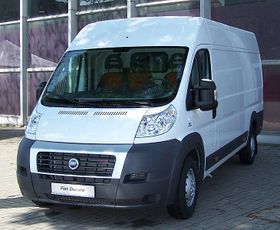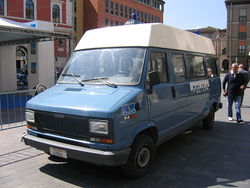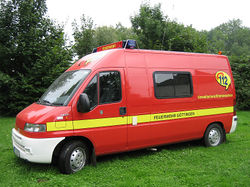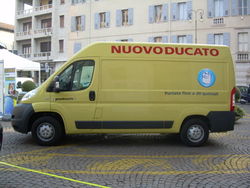Difference between revisions of "Fiat Ducato"
m |
m |
||
| (12 intermediate revisions by the same user not shown) | |||
| Line 1: | Line 1: | ||
{{X}} | {{X}} | ||
| − | [[Image: | + | {| border=1 cellspacing=3 cellpadding=4 style="float:right; margin:0 0 .5em 1em; width:280px; background:#505050; border-collapse:collapse; border:1px solid #999; font-size:83%; line-height:1.5; " summary="Infobox Automobile" |
| + | |- style="text-align:center; background:#505050;" | ||
| + | | colspan=2 style="padding:0; background:#505050; color:#fff; border-bottom:1px solid #999;" |[[Image:Fiat Ducato MTP07.jpg|280px]] '''Fiat Ducato Mark 3''' | ||
| + | |- style="color:#fff; background:darkred; font-size:larger;" | ||
| + | ! colspan=2 |'''Fiat Ducato''' | ||
| + | |- | ||
| + | | Manufacturer || [[Sevel Sud]]<br>[[Fiat]] | ||
| + | |- | ||
| + | | Assembly || [[Val di Sangro]], [[Atessa]], [[Italy]]<br>[[Sete Lagoas]], [[Minas Gerais]], [[Brazil]] | ||
| + | |- | ||
| + | | Production || 1981-present | ||
| + | |- | ||
| + | | Predecessor || [[Fiat 238]] | ||
| + | |- | ||
| + | | Successor || | ||
| + | |- | ||
| + | | Class || [[Light commercial vehicle|LCV]] | ||
| + | |- | ||
| + | | Related || (1st Gen):<br>[[Alfa Romeo]] AR6<br>[[Peugeot J5]]<br>[[Citroën C25]]<br>[[Talbot Express]]<br>(2nd Gen)<br>[[Peugeot Boxer]]<br>[[Citroën Jumper]]<br>[[Zastava]] Ducato<br>(3rd Gen)<br>[[Peugeot Boxer]]<br>[[Citroën Jumper]] | ||
| + | |- | ||
| + | | Similar || [[Ford Transit]]<BR>[[Mercedes-Benz Sprinter]]<br>[[Volkswagen Transporter]] | ||
| + | |- | ||
| + | | Designer || | ||
| + | |- | ||
| + | | Video || '''Fiat Ducato Commercial''' | ||
| + | |- | ||
| + | | colspan=2 style="padding:0; background:#333333; color:#fff; border-bottom:1px solid #999;" |<videoflash>6f4ZjIfHmTc|280|200</videoflash> | ||
| + | |} | ||
| − | The '''Fiat Ducato''' is a large [[van]] produced by [[Fiat]]. The Fiat Ducato is the same van as the [[ | + | The '''Fiat Ducato''' is a large [[van]] produced by [[Fiat]]. <!-- It has been produced since [[1981]]?. --> |
| + | The Fiat Ducato is the same van as the [[Citroën Jumper]] and the [[Peugeot Boxer]], which are all very popular vans to convert into [[motorhome]]s. All these models are produced at the same Fiat factories in Italy and Brazil, and under licence in Elabuga (Russia) by Russian automobile company Sollers (formerly Severstal Auto) since 2008. Sollers also produces UAZ off-roaders, Ssangyong (South Korea) and other Fiat platforms under licence. Russian conglomerate Severstal divested the division Severstal-Auto in 2001, and the company changed its name to Sollers in 2008. | ||
| − | + | Since 1981, more than 2 million Fiat Ducato vehicles have been produced. | |
| + | |||
| − | + | ==First generation (1981–1993)== | |
| + | [[Image:It police truck.jpg|250px|thumb|left|Ducato first series]] | ||
| + | Ducato was first launched in 1981 then redesigned for 1993: engines were 2.0-litre 4-cylinder petrol or 1.9 [[Diesel engine|diesel]]. Trim levels were base, S and SX. Car was manufactured in new [[Sevel Sud|Sevel Sud factory]] in [[Val di Sangro]], Italy. Other almost identical cars were: [[Alfa Romeo AR6]], [[Peugeot J5]], [[Citroën C25]] and [[Talbot Express]] (1986–1992). Model variants were named after the carrying capacity: Ducato 10 (1.0 tons), Ducato 13 (1.3 tons), Ducato 14 (1.4 tons) and Ducato Maxi 18 (1.8 tons). Ducato Mk1 was very popular like [[campervan]]. | ||
| − | |||
| − | The Ducato Combi is a mixture of the Goods Transport and the [[Passenger]] Transport. It is ideal for the transport of people and goods alike, and it can accommodate up to 9 occupants. | + | |
| + | |||
| + | |||
| + | |||
| + | |||
| + | |||
| + | ===Engines first series=== | ||
| + | {| border=1 cellspacing=3 cellpadding=4 style="float:center; margin:0 0 .5em 1em; width:300px; background:#505050; border-collapse:collapse; border:1px solid #999; font-size:83%; line-height:1.5; " summary="Infobox Automobile" | ||
| + | |- style="text-align:center; background:#505050;" | ||
| + | |- tr BGCOLOR=darkred | ||
| + | | '''Model''' || '''Type'''|| '''Power''' | ||
| + | |----- | ||
| + | |1.8||[[petrol]]|| 69 PS | ||
| + | |----- | ||
| + | |2.0||petrol|| 75 PS | ||
| + | |----- | ||
| + | |2.0||petrol|| 84 PS | ||
| + | |----- | ||
| + | |1.9||[[Diesel engine|diesel]]|| 70 PS | ||
| + | |----- | ||
| + | |2.5||diesel|| 74 PS | ||
| + | |----- | ||
| + | |2.5TD||diesel|| 95 PS | ||
| + | |} | ||
| + | |||
| + | |||
| + | ==Second generation (1994–2006)== | ||
| + | [[Image:ABC-ErkKw.jpg|250px|thumb|right|Ducato second series]] | ||
| + | [[Image:Florian Borken 2-83-3 (16.04.2004).JPG|250px|thumb|right|Ducato second series]] | ||
| + | [[Image:MHV Fiat Ducato 2006 01.jpg|250px|thumb|right|Facelifted 2nd gen. Ducato Mobile Home (2006)]] | ||
| + | [[Image:Ducato pmesp ambiental.jpg|250px|thumb|right|Facelifted 2nd gen. police Ducato in [[São Paulo]]]] | ||
| + | New Sevel produced version. Peugeot changed its name to Boxer and Citroën is named as Jumper (Relay in the UK). One of engine options was Fiat 2.5 L diesel, which was replaced with 2.8 L [[Iveco]]/Sofim engine in 1998 . | ||
| + | |||
| + | The Ducato Goods [[Transport]] has a payload of 12 m cubed and comes with a choice of four [[engines]]. The 2.0 petrol, 2.0 JTD, 2.3 JTD 16v or the 2.8 JTD. They all conform to the Euro 3 standards and offer programmed [[Maintenance, repair and operations|maintenance]] management. The range includes two types of [[gearbox]]: a mechanical box with five speeds plus reverse and an automatic [[Transmission (mechanics)|transmission]] with four speeds plus reverse. | ||
| + | |||
| + | The Ducato Passenger Transport has a carrying [[capacity]] of 6 to 9 people and comes with the 2.3 litre JTD 16v engine, which again is Euro 3 compliant and delivers 110 bhp. | ||
| + | |||
| + | The Ducato Combi is a mixture of the Goods Transport and the [[Passenger]] Transport. It is ideal for the transport of people and goods alike, and it can accommodate up to 9 occupants. Model designations were Ducato 10 (1 ton), Ducato 14 (1.4 tons and Ducato Maxi 18 (1.8 tons). | ||
| + | |||
| + | Second series was restyled in 2003 with the addition of rear and side bump mouldings and revised front grille. The engine range was: 2.0 JTD, 2.3 JTD 16v and 2.8 JTD, 2.5 diesel was dropped way. Model designations were this time: Ducato 29 (2.9 tons), Ducato 30 (3.0 tons), Ducato 33 (3.3 tons) and Ducato Maxi 35 (3.5 tons). | ||
| + | |||
| + | |||
| + | ===Engines second generation 1994-1999=== | ||
| + | {| border=1 cellspacing=3 cellpadding=4 style="float:center; margin:0 0 .5em 1em; width:300px; background:#505050; border-collapse:collapse; border:1px solid #999; font-size:83%; line-height:1.5; " summary="Infobox Automobile" | ||
| + | |- style="text-align:center; background:#505050;" | ||
| + | |- tr BGCOLOR=darkred | ||
| + | | '''Model''' || '''Type'''|| '''Power''' | ||
| + | |----- | ||
| + | |2.0||[[petrol]]|| 100 PS | ||
| + | |----- | ||
| + | |2.0D||diesel|| 81 PS | ||
| + | |----- | ||
| + | |1.9TD||[[Diesel engine|diesel]]|| 82 PS - 90 PS | ||
| + | |----- | ||
| + | |2.5D||diesel|| 100 PS | ||
| + | |----- | ||
| + | |2.5TDI||diesel|| 115 PS | ||
| + | |----- | ||
| + | |2.8D||diesel|| 87 PS | ||
| + | |----- | ||
| + | |2.8TD||diesel|| 139 PS | ||
| + | |} | ||
| + | |||
| + | |||
| + | ===Engines second generation 1999-2003=== | ||
| + | {| border=1 cellspacing=3 cellpadding=4 style="float:center; margin:0 0 .5em 1em; width:300px; background:#505050; border-collapse:collapse; border:1px solid #999; font-size:83%; line-height:1.5; " summary="Infobox Automobile" | ||
| + | |- style="text-align:center; background:#505050;" | ||
| + | |- tr BGCOLOR=darkred | ||
| + | | '''Model''' || '''Type'''|| '''Power''' | ||
| + | |----- | ||
| + | |2.0||[[petrol]]|| 100 PS | ||
| + | |----- | ||
| + | |1.9D||diesel|| 85 PS | ||
| + | |----- | ||
| + | |1.9TD||diesel|| 90 PS | ||
| + | |----- | ||
| + | |2.0[[JTD]]||[[Diesel engine|diesel]]|| 100 PS | ||
| + | |----- | ||
| + | |2.3JTD||diesel|| 110 PS | ||
| + | |----- | ||
| + | |2.5TDI||diesel|| 116 PS | ||
| + | |----- | ||
| + | |2.8i.d.TD||diesel|| 125 PS | ||
| + | |} | ||
| + | |||
| + | |||
| + | ===Engines second generation (facelift)=== | ||
| + | {| border=1 cellspacing=3 cellpadding=4 style="float:center; margin:0 0 .5em 1em; width:300px; background:#505050; border-collapse:collapse; border:1px solid #999; font-size:83%; line-height:1.5; " summary="Infobox Automobile" | ||
| + | |- style="text-align:center; background:#505050;" | ||
| + | |- tr BGCOLOR=darkred | ||
| + | | '''Model''' || '''Type'''|| '''Power''' | ||
| + | |----- | ||
| + | |2.0||[[petrol]]|| 110 PS | ||
| + | |----- | ||
| + | |2.0 natural power||[[compressed natural gas|CNG]]|| 110 PS | ||
| + | |----- | ||
| + | |2.0 G power||[[Liquefied petroleum gas|LPG]]|| 110 PS | ||
| + | |----- | ||
| + | |2.0[[JTD]]||[[Diesel engine|diesel]]|| 84 PS | ||
| + | |----- | ||
| + | |2.3 JTD 16V||diesel|| 110 PS | ||
| + | |----- | ||
| + | |2.8 JTD||diesel|| 127 PS | ||
| + | |----- | ||
| + | |2.3 Multijet ([[Brazil|Brazil]] - 2009) 16V||diesel|| 127 PS | ||
| + | |----- | ||
| + | |2.8 JTD Power||diesel|| 146 PS | ||
| + | |} | ||
| + | |||
| + | |||
| + | ==Third generation (2006–)== | ||
| + | [[Image:Ducato 3 lat.JPG|250px|thumb|right|Ducato third series]] | ||
| + | [[Image:Fiat Ducato Pritsche front 20081223.jpg|250px|thumb|right|Ducato third series]] | ||
| + | The third generation Ducato was launched in 2006. The vehicle was available in many variants both for people and goods transport. Carrying capacity was again increased, with the following designations: Ducato 30 (3 tons), Ducato 33 (3.3 tons), Ducato Maxi 35 (3.5 tons) and Ducato Maxi 40 (4 tons). | ||
| + | |||
| + | |||
| + | ===Engines third generation=== | ||
| + | {| border=1 cellspacing=3 cellpadding=4 style="float:center; margin:0 0 .5em 1em; width:300px; background:#505050; border-collapse:collapse; border:1px solid #999; font-size:83%; line-height:1.5; " summary="Infobox Automobile" | ||
| + | |- style="text-align:center; background:#505050;" | ||
| + | |- tr BGCOLOR=darkred | ||
| + | | '''Model''' || '''Type'''|| '''Power''' | ||
| + | |----- | ||
| + | |2.2 Multijet||[[Diesel engine|diesel]]|| 100 PS | ||
| + | |----- | ||
| + | |2.3 Multijet||diesel|| 120 PS | ||
| + | |----- | ||
| + | |2.3 Multijet||diesel|| 130 PS | ||
| + | |----- | ||
| + | |3.0 Multijet Power||diesel|| 157 PS | ||
| + | |} | ||
| + | |||
| + | |||
| + | ==Fiat Ducato and Peugeot Manager in Mexico== | ||
| + | This third generation Ducato has been available in Mexico since November 15, 2007 and over 30 different models are available. The third generation Ducato is currently only offered in the Mexican market in North America, but Fiat plans to import the vehicle to the United States in Canada to be sold at Dodge dealers. | ||
| + | |||
| + | As part of the joint venture between PSA Peugeot Citroen and Fiat Group, the Peugeot version of the Fiat Ducato, known as Boxer in Europe, is also available in Mexico, but with the "Manager" nametag. | ||
| Line 17: | Line 182: | ||
{{Modern European Fiat vehicles}} | {{Modern European Fiat vehicles}} | ||
{{Fiat SPA}} | {{Fiat SPA}} | ||
| + | |||
[[Category:Fiat vehicles|Ducato]] | [[Category:Fiat vehicles|Ducato]] | ||
| + | [[Category:Vans]] | ||
| + | [[Category:Vehicles introduced in 1981]] | ||
Latest revision as of 22:15, 31 October 2009
 Fiat Ducato Mark 3 Fiat Ducato Mark 3
| |
| Fiat Ducato | |
|---|---|
| Manufacturer | Sevel Sud Fiat |
| Assembly | Val di Sangro, Atessa, Italy Sete Lagoas, Minas Gerais, Brazil |
| Production | 1981-present |
| Predecessor | Fiat 238 |
| Successor | |
| Class | LCV |
| Related | (1st Gen): Alfa Romeo AR6 Peugeot J5 Citroën C25 Talbot Express (2nd Gen) Peugeot Boxer Citroën Jumper Zastava Ducato (3rd Gen) Peugeot Boxer Citroën Jumper |
| Similar | Ford Transit Mercedes-Benz Sprinter Volkswagen Transporter |
| Designer | |
| Video | Fiat Ducato Commercial |
The Fiat Ducato is a large van produced by Fiat.
The Fiat Ducato is the same van as the Citroën Jumper and the Peugeot Boxer, which are all very popular vans to convert into motorhomes. All these models are produced at the same Fiat factories in Italy and Brazil, and under licence in Elabuga (Russia) by Russian automobile company Sollers (formerly Severstal Auto) since 2008. Sollers also produces UAZ off-roaders, Ssangyong (South Korea) and other Fiat platforms under licence. Russian conglomerate Severstal divested the division Severstal-Auto in 2001, and the company changed its name to Sollers in 2008.
Since 1981, more than 2 million Fiat Ducato vehicles have been produced.
First generation (1981–1993)
Ducato was first launched in 1981 then redesigned for 1993: engines were 2.0-litre 4-cylinder petrol or 1.9 diesel. Trim levels were base, S and SX. Car was manufactured in new Sevel Sud factory in Val di Sangro, Italy. Other almost identical cars were: Alfa Romeo AR6, Peugeot J5, Citroën C25 and Talbot Express (1986–1992). Model variants were named after the carrying capacity: Ducato 10 (1.0 tons), Ducato 13 (1.3 tons), Ducato 14 (1.4 tons) and Ducato Maxi 18 (1.8 tons). Ducato Mk1 was very popular like campervan.
Engines first series
| Model | Type | Power |
| 1.8 | petrol | 69 PS |
| 2.0 | petrol | 75 PS |
| 2.0 | petrol | 84 PS |
| 1.9 | diesel | 70 PS |
| 2.5 | diesel | 74 PS |
| 2.5TD | diesel | 95 PS |
Second generation (1994–2006)

New Sevel produced version. Peugeot changed its name to Boxer and Citroën is named as Jumper (Relay in the UK). One of engine options was Fiat 2.5 L diesel, which was replaced with 2.8 L Iveco/Sofim engine in 1998 .
The Ducato Goods Transport has a payload of 12 m cubed and comes with a choice of four engines. The 2.0 petrol, 2.0 JTD, 2.3 JTD 16v or the 2.8 JTD. They all conform to the Euro 3 standards and offer programmed maintenance management. The range includes two types of gearbox: a mechanical box with five speeds plus reverse and an automatic transmission with four speeds plus reverse.
The Ducato Passenger Transport has a carrying capacity of 6 to 9 people and comes with the 2.3 litre JTD 16v engine, which again is Euro 3 compliant and delivers 110 bhp.
The Ducato Combi is a mixture of the Goods Transport and the Passenger Transport. It is ideal for the transport of people and goods alike, and it can accommodate up to 9 occupants. Model designations were Ducato 10 (1 ton), Ducato 14 (1.4 tons and Ducato Maxi 18 (1.8 tons).
Second series was restyled in 2003 with the addition of rear and side bump mouldings and revised front grille. The engine range was: 2.0 JTD, 2.3 JTD 16v and 2.8 JTD, 2.5 diesel was dropped way. Model designations were this time: Ducato 29 (2.9 tons), Ducato 30 (3.0 tons), Ducato 33 (3.3 tons) and Ducato Maxi 35 (3.5 tons).
Engines second generation 1994-1999
| Model | Type | Power |
| 2.0 | petrol | 100 PS |
| 2.0D | diesel | 81 PS |
| 1.9TD | diesel | 82 PS - 90 PS |
| 2.5D | diesel | 100 PS |
| 2.5TDI | diesel | 115 PS |
| 2.8D | diesel | 87 PS |
| 2.8TD | diesel | 139 PS |
Engines second generation 1999-2003
| Model | Type | Power |
| 2.0 | petrol | 100 PS |
| 1.9D | diesel | 85 PS |
| 1.9TD | diesel | 90 PS |
| 2.0JTD | diesel | 100 PS |
| 2.3JTD | diesel | 110 PS |
| 2.5TDI | diesel | 116 PS |
| 2.8i.d.TD | diesel | 125 PS |
Engines second generation (facelift)
| Model | Type | Power |
| 2.0 | petrol | 110 PS |
| 2.0 natural power | CNG | 110 PS |
| 2.0 G power | LPG | 110 PS |
| 2.0JTD | diesel | 84 PS |
| 2.3 JTD 16V | diesel | 110 PS |
| 2.8 JTD | diesel | 127 PS |
| 2.3 Multijet (Brazil - 2009) 16V | diesel | 127 PS |
| 2.8 JTD Power | diesel | 146 PS |
Third generation (2006–)
The third generation Ducato was launched in 2006. The vehicle was available in many variants both for people and goods transport. Carrying capacity was again increased, with the following designations: Ducato 30 (3 tons), Ducato 33 (3.3 tons), Ducato Maxi 35 (3.5 tons) and Ducato Maxi 40 (4 tons).
Engines third generation
| Model | Type | Power |
| 2.2 Multijet | diesel | 100 PS |
| 2.3 Multijet | diesel | 120 PS |
| 2.3 Multijet | diesel | 130 PS |
| 3.0 Multijet Power | diesel | 157 PS |
Fiat Ducato and Peugeot Manager in Mexico
This third generation Ducato has been available in Mexico since November 15, 2007 and over 30 different models are available. The third generation Ducato is currently only offered in the Mexican market in North America, but Fiat plans to import the vehicle to the United States in Canada to be sold at Dodge dealers.
As part of the joint venture between PSA Peugeot Citroen and Fiat Group, the Peugeot version of the Fiat Ducato, known as Boxer in Europe, is also available in Mexico, but with the "Manager" nametag.
| <- Older Models | Fiat car timeline, European market, 1980s - present | |||||||||||||||||||||||||||||||||||||||
| Type | 1980s | 1990s | 2000s | 2010s | ||||||||||||||||||||||||||||||||||||
| 0 | 1 | 2 | 3 | 4 | 5 | 6 | 7 | 8 | 9 | 0 | 1 | 2 | 3 | 4 | 5 | 6 | 7 | 8 | 9 | 0 | 1 | 2 | 3 | 4 | 5 | 6 | 7 | 8 | 9 | 0 | 1 | 2 | 3 | 4 | 5 | |||||
| City cars | 126 | Cinquecento | Seicento (1998-2005) / 600 (2005-2010) | |||||||||||||||||||||||||||||||||||||
| 500 | ||||||||||||||||||||||||||||||||||||||||
| Panda I | Panda II | |||||||||||||||||||||||||||||||||||||||
| Supermini | 127 | Uno | Punto I | Punto II | ||||||||||||||||||||||||||||||||||||
| Grande Punto | Punto Evo | |||||||||||||||||||||||||||||||||||||||
| Small family car |
Ritmo | Tipo | Bravo / Brava | Stilo | Bravo II | |||||||||||||||||||||||||||||||||||
| 131 | Regata | Tempra | Marea | Linea | ||||||||||||||||||||||||||||||||||||
| Albea | ||||||||||||||||||||||||||||||||||||||||
| Large family car | 132 | Argenta | Croma I | Croma II | ||||||||||||||||||||||||||||||||||||
| Coupé | Coupé | |||||||||||||||||||||||||||||||||||||||
| Roadster | 124 Spider | Barchetta | Barchetta | |||||||||||||||||||||||||||||||||||||
| Sports car | X1/9 | |||||||||||||||||||||||||||||||||||||||
| Panel van/Leisure activity vehicle | Fiorino I | Fiorino II | Fiorino III | |||||||||||||||||||||||||||||||||||||
| Doblò | ||||||||||||||||||||||||||||||||||||||||
| Mini SUV | Sedici | |||||||||||||||||||||||||||||||||||||||
| Mini MPV | Idea | |||||||||||||||||||||||||||||||||||||||
| Compact MPV | Multipla | |||||||||||||||||||||||||||||||||||||||
| Large MPV | Ulysse I | Ulysse II | ||||||||||||||||||||||||||||||||||||||
| Van | Daily* | Scudo I | Scudo II | |||||||||||||||||||||||||||||||||||||
| Ducato I | Ducato II | Ducato III | ||||||||||||||||||||||||||||||||||||||
| Mini Pickup | Strada | |||||||||||||||||||||||||||||||||||||||
| Off-road | Campagnola (1107) | |||||||||||||||||||||||||||||||||||||||
| *Rebadged Iveco model | ||||||||||||||||||||||||||||||||||||||||





